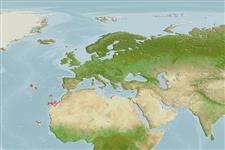Issue
Will eventually be assigned to a new genus.
Environment: milieu / climate zone / depth range / distribution range
Ecology
Marine; reef-associated; non-migratory; depth range 0 - 25 m. Subtropical; 40°N - 13°N, 29°W - 11°W (Ref. 56021)
Eastern Atlantic: including Madeira, Azores, Ilheus Selvagens, Canary Islands, Cape Verde, and Senegal.
Size / Weight / Age
Maturity: Lm ? range ? - ? cm
Max length : 15.0 cm TL male/unsexed; (Ref. 27000)
Adults inhabit rocky inshore areas, often near sand; juveniles found in tide pools. Food comprised mainly of algae with associated minute invertebrates (Ref. 6760). Males protect the eggs deposited in nests (Ref. 6760).
Life cycle and mating behavior
Maturity | Reproduction | Spawning | Eggs | Fecundity | Larvae
Oviparous, distinct pairing during breeding (Ref. 205). Eggs are demersal and adhere to the substrate (Ref. 205). Males protect the eggs deposited in nests (Ref. 6760).
Allen, G.R., 1991. Damselfishes of the world. Mergus Publishers, Melle, Germany. 271 p. (Ref. 7247)
IUCN Red List Status (Ref. 130435: Version 2024-2)
Threat to humans
Harmless
Human uses
Tools
Special reports
Download XML
Internet sources
Estimates based on models
Preferred temperature (Ref.
123201): 18.7 - 24.5, mean 20.2 °C (based on 85 cells).
Phylogenetic diversity index (Ref.
82804): PD
50 = 0.7500 [Uniqueness, from 0.5 = low to 2.0 = high].
Bayesian length-weight: a=0.01259 (0.00497 - 0.03190), b=3.04 (2.82 - 3.26), in cm total length, based on LWR estimates for this (Sub)family-body shape (Ref.
93245).
Trophic level (Ref.
69278): 3.5 ±0.37 se; based on food items.
Resilience (Ref.
120179): High, minimum population doubling time less than 15 months (Preliminary K or Fecundity.).
Fishing Vulnerability (Ref.
59153): Low vulnerability (10 of 100).
Climate Vulnerability (Ref.
125649): High to very high vulnerability (71 of 100).
Nutrients (Ref.
124155): Calcium = 54.3 [24.9, 116.4] mg/100g; Iron = 0.693 [0.403, 1.170] mg/100g; Protein = 19.7 [18.7, 20.7] %; Omega3 = 0.234 [0.135, 0.397] g/100g; Selenium = 10.1 [4.9, 20.4] μg/100g; VitaminA = 85.5 [28.8, 262.9] μg/100g; Zinc = 1.07 [0.69, 1.62] mg/100g (wet weight);
